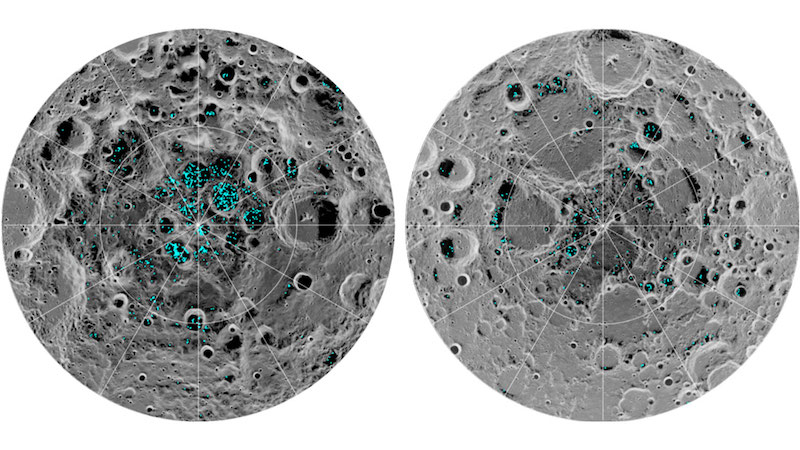
Moon water from ancient volcanoes?
We think of the moon today as a dry, dusty, rocky world. But, the moon does also have water ice, found mostly in permanently-shadowed craters near its poles. In May 2022, scientists at the University of Colorado Boulder (CU Boulder) said they’ve identified more possible ice near the moon’s poles, created by ancient volcanoes. Future astronauts might use these thick sheets of subsurface ice as a water source.
The researchers published their peer-reviewed results in The Planetary Science Journal on May 3, 2022.
A world of fire and ice
The moon was quite a different place 2 to 4 billion years ago, when thousands of volcanoes were erupting on its surface, creating rivers and lakes of lava. The lava outpourings from these volcanic eruptions on the moon created the famous dark maria (or “seas”) we see on the moon’s Earth-facing hemisphere. And these eruptions were huge, larger than most on Earth. Paul Hayne, a co-author, said:
They dwarf almost all of the eruptions on Earth.
And, as it turns out, lava isn’t the only thing the moon’s volcanoes produced. They also released large amounts of water vapor, which the researchers said condensed onto the moon’s surface and formed ice.

Moon water in temporary atmospheres
Today, the moon is virtually airless. But the scientists said these ancient moon volcanoes also created clouds composed of carbon monoxide and water vapor. The clouds swirled around the moon, forming temporary atmospheres. In those conditions, water vapor could have settled onto the surface as a kind of frost. That frost built up over time, creating layers up to hundreds of feet thick. Andrew Wilcoski, lead author of the new study at the Department of Astrophysical and Planetary Sciences (APS) and the Laboratory for Atmospheric and Space Physics (LASP) at CU Boulder, stated that:
We envision it as a frost on the moon that built up over time.
That frost-turned-ice is likely still on the moon today, the researchers say, as sheets of ice just beneath the surface. Hayne said:
It’s possible that 5 or 10 meters [15-30 feet] below the surface, you have big sheets of ice.
Another earlier study from 2020 suggested that nearly 6,000 square miles (about 15,000 square km) of the moon’s surface could still contain ice now. Volcanoes might be just one of the sources for that water.

How much ice is there?
So, just how much ice could have formed in these temporary lunar atmospheres? To find out, Hayne and Wilcoski, along with Margaret Landis at LASP at CU Boulder, set out to do some estimates. As it turns out, the moon may have been icier back then than previously thought. The team estimated that a massive eruption occurred about once every 22,000 years, on average.
From that, they calculated that a large amount of water vapor from those eruptions – about 41% – condensed onto the moon’s surface as frost/ice. Even though the atmospheres were temporary, they lasted about 1,000 years each time they formed. They dissipated very slowly during that period each time, until they were completely gone again. However, that’s more than enough time for ice to have formed. According to Wilcoski:
The atmospheres escaped over about 1,000 years, so there was plenty of time for ice to form.

A source of water for future astronauts?
Those ice sheets contained a lot of water, the researchers say. About 18 quadrillion pounds of volcanic water, in fact. Moreover, both the frost and thicker polar ice caps may have been visible from Earth. How cool (literally) would it have been to see that? Ice caps on the moon!
The researchers say that most of that water ice should still be present today. If so, future astronauts could use it as a source of much-needed water. They might have to dig a bit, though, as the ice is probably under several feet of lunar regolith (dust and rocks). Wilcoski added:
We need to drill down and look for it.
Bottom line: Much of our moon’s ice likely came from ancient volcanoes, researchers say. The ice first formed as frost during times when the moon had temporary atmospheres created by volcanic eruptions. The ice could provide valuable drinking water for future lunar astronauts.
Source: Polar Ice Accumulation from Volcanically Induced Transient Atmospheres on the Moon











